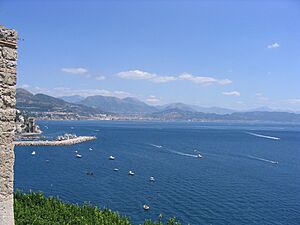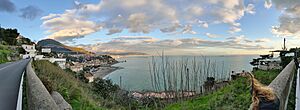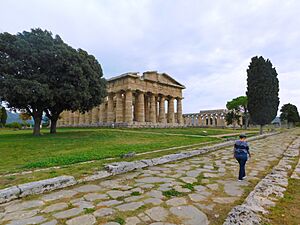Gulf of Salerno facts for kids
The Gulf of Salerno (in Italian: Golfo di Salerno) is a large bay on the coast of Salerno province in southwestern Italy. It's part of the Tyrrhenian Sea.
This beautiful gulf has different types of coastlines. To the north, you'll find the famous Amalfi Coast, known for its stunning cliffs and charming towns like Amalfi, Maiori, Positano, and the city of Salerno. This northern part is sometimes called the "Divina Costiera" because it's so beautiful. The rocky Lattari Mountains drop right into the sea here.
To the east, the coast is flat and sandy, with some pine forests. This area is called the Sele plain. To the south, you'll find the Cilento coast. The Gulf of Salerno is separated from the Gulf of Naples by the Sorrentine Peninsula to the north.
Contents
History of the Gulf of Salerno
The Gulf of Salerno has a long and interesting history, going back thousands of years!
Ancient Times
Long before the Roman Empire became powerful, ancient tribes lived around the Gulf of Salerno. One of the oldest cities, Paestum, was founded during this time. The city of Salerno itself was started by the Etruscans around 300 BC. It quickly became an important place in the region.
The Roman Era
When the Roman Empire grew, Salerno became a key Roman colony. It was known for producing many goods. The gulf was a busy place for trade and travel, giving Romans easy access to the sea. The town of Amalfi is thought to have been founded by a Roman family who settled there after their ship ran aground.
The Medieval Period
In the Middle Ages, Salerno and the areas around it were part of the Lombard Duchy of Salerno. Salerno was a center for learning and culture. A famous medical school, the Schola Medica Salernitana, was established here in the 9th and 10th centuries. It was one of the first and most important medical schools in Europe!
The town of Amalfi became the capital of the Duchy of Amalfi, a powerful trading republic. It was a major player in Mediterranean trade between 839 and about 1200.
Norman Conquest and Changes
In 1076, the Normans, led by Robert Guiscard, conquered Salerno. This brought big changes to the area. The Saint Matthew Cathedral was built and dedicated in 1084. Later, in 1150, the University of Salerno was founded. The construction of the Port of Salerno also began in 1260.
Later Centuries
Salerno and the Gulf continued to be important during the Renaissance. However, over time, other cities like Naples and Palermo grew larger and became more central for trade and culture.
Modern History
In more recent times, the Gulf of Salerno has continued to be a place of interest. Artists like Joseph Wright of Derby visited and painted its beautiful scenes. During World War II, the gulf played a very important role. It was a major landing point for the Allied forces in 1943 during the Italian Campaign.
Climate of the Gulf
The Gulf of Salerno has a typical Mediterranean climate. This means it has mild winters with some rain, and hot summers that can feel humid.
The area enjoys a lot of sunshine, with at least 250 sunny days each year. This makes it a popular place for tourists not just in summer, but also in spring and autumn!
See also
 In Spanish: Golfo de Salerno para niños
In Spanish: Golfo de Salerno para niños




